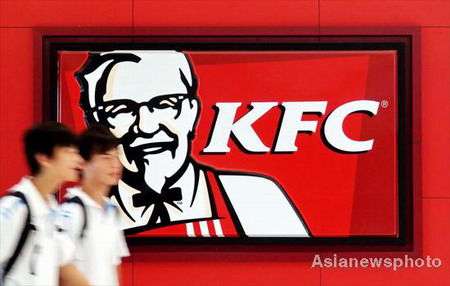Local firms vie for Yum's slice of China market
Updated: 2012-02-06 11:14
(Agencies)
|
||||||||
BEIJING - Four floors up overlooking the bustle of the cavernous Joy City Mall in Beijing, diners take a break from shopping to slurp noodles and nibble on dumplings at an Ajisen restaurant.
It's an increasingly common sight: Chinese consumers turning to local fast-food alternatives to the long-dominant pair in China -- Yum Brands Inc's KFC and McDonalds Corp.
Twenty-five years after Yum introduced China to American-style fast food with its first fried chicken store, the two US giants are facing a plethora of Chinese and Asian eatery chains that are steadily munching away at their market share.
 People pass a KFC billboard in Shanghai, June 30, 2011. [Photo / Asianewsphoto]
|
As Yum prepares to announce fourth-quarter earnings on Monday, some investors are eyeing its China operations warily. Last week saw a flurry of put options on Yum after McDonalds reported earnings and said foreign exchange fluctuations and other factors could eat into profits in 2012.
But Yum's China business seems robust. The company said on December 5 that it expects a benefit of $40 million this year from yuan-dollar exchange rates, while operating profit in China is expected to grow 15 percent. It plans to open 600 more locations in China in 2012 at a pace of more than one every day.
China accounted for 36 percent of Yum's global revenue in 2010 and is estimated to be 44 percent in 2011 and 50 percent in 2012, according to Credit Suisse.
Yum's biggest challenge comes from a rising torrent of competition as Chinese consumers increasingly have more money to spend and more places to spend it, which could mean slowing growth rates for Yum in the future.
At the Ajisen outlet, stacked above a Starbucks coffee shop and a Burger King restaurant, shoppers headed in and out all afternoon.
"We were just browsing, and stopped here by chance to eat," said Sun Haihao, 30, an engineer from Sichuan province who was visiting Beijing.
He's been to Ajisen, a Japanese-style restaurant run by Ajisen (China) holdings Ltd and KFC in Mianyang city where he lives. "KFC can be too oily," Sun said. "Ajisen is Asian, so we're used to it."
Growth outpaces China's GDP
A recent Reuters poll showed that economists expect China's GDP to grow 8.4 percent this year, down from 9.2 percent in 2011. Meanwhile the quick-service restaurant industry is expected to grow around 15 percent, meaning further revenue growth for Yum and McDonalds, even as their market share declines, according to market research firm Mintel."KFC and McDonalds are growing outlet numbers, but so are domestic and foreign chains plus independents," says Paul French, Mintel's chief China analyst. "The pie is bigger, but the number of players wanting and getting a slice of it are bigger too. A rising tide does not necessarily raise all boats."
Ajisen is among the legion of upstarts, which include fellow Japanese entrant Yoshinoya; Taiwan-owned Dico's restaurants and 85 Degrees Bakery; Burger King, Dairy Queen and Papa John's Pizza from the United States; South Korean-owned Paris Baguette and Tous Les Jours bakeries; and a host of Chinese chains such as Golden Jaguar, Yonghe King and Country Style Cooking.
Many are growing fast, albeit from a smaller base. Ajisen (China) reported a boost in first-half restaurant income last August of 40.8 percent to HK$1.6 billion ($206 million).
Country Style Cooking, a family-style chain offering casual cuisine and focused on western China, increased its locations by 63 percent in 2011, according to China Market Research. Meanwhile, the number of all of Yum brand restaurants in China last year grew 13 percent.
Success story
Louisville, Kentucky-based Yum, whose restaurants in China also include Pizza Hut, East Dawning and a stake in Little Sheep, plus Taco Bell and others in the United States, has had remarkable success in China.
 Relief reaches isolated village
Relief reaches isolated village
 Rainfall poses new threats to quake-hit region
Rainfall poses new threats to quake-hit region
 Funerals begin for Boston bombing victims
Funerals begin for Boston bombing victims
 Quake takeaway from China's Air Force
Quake takeaway from China's Air Force
 Obama celebrates young inventors at science fair
Obama celebrates young inventors at science fair
 Earth Day marked around the world
Earth Day marked around the world
 Volunteer team helping students find sense of normalcy
Volunteer team helping students find sense of normalcy
 Ethnic groups quick to join rescue efforts
Ethnic groups quick to join rescue efforts
Most Viewed
Editor's Picks

|

|

|

|

|

|
Today's Top News
Health new priority for quake zone
Xi meets US top military officer
Japan's boats driven out of Diaoyu
China mulls online shopping legislation
Bird flu death toll rises to 22
Putin appoints new ambassador to China
Japanese ships blocked from Diaoyu Islands
Inspired by Guan, more Chinese pick up golf
US Weekly

|

|







